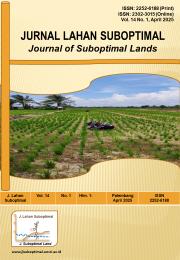Performance of intercropping corn on manure oil palm plantations on dry land
DOI:
https://doi.org/10.36706/jlso.14.1.2025.718Keywords:
food crops, frond staking, path, plantation crops, polycultureAbstract
The intercroping area (IC) is around 0.5 ha from one hectare of mature oil palm (YH). The research aimed to observe the growth and yield of corn from the Bisi 16 variety in oil palm plantations from the SJ 5 variety and the effect of corn as IC on oil palm. The research location was in Mesuji Raya Sub-district, Ogan Komering Ilir, South Sumatra, from April 2024 to July 2024. The interspace number of oil palm of 1 ha were 12 and it was six interspaces as the object research was as frond staking. The research method used was non-experimental. Each of front staking had two sample plots of corn (3×3 m), and samples selected for each plot were 15 crops. For oil palm (8×8×8 m) two samples of crops were beside the corn plot. The total of oil palm samples was 24 crops from oil palm IC, and compared to 24 crops from monoculture. The research results showed that the growth of IC corn was lower for plant height (16%), and the reduction in corn yield (26%) from one ha compared to the description. The total yield from corn IC was approximately 2.09 tons of corn shells, which were lower from monoculture description. The growth and yield of oil palm IC were better than monoculture, with an increase a number of fruit bunches (9%) and FFB weight (11%). Corn is an intercrop/polyculture crop in oil palm plantations after one or two years of production.
References
Akmalia, H. A., & Suharyanto, S. (2017). Effect of differences in light intensity and watering on corn growth (Zea Mays L.) ‘Sweet Boy-02.’ Jurnal Sains Dasar, 6(1), 8. https://doi.org/10.21831/jsd.v6i1.13403
Andayani, N. N., Riadi, M., Rafiuddin, Kalqutny, S. H., Efendi, R., & Azrai, M. (2020). Evaluation of yield and agronomic components of three-way cross maize hybrids under low-light environment. IOP Conference Series: Earth and Environmental Science, 484(1). https://doi.org/10.1088/1755-1315/484/1/012016
Arifin, Y. F., Noor, I., Budiman, A., & Wibowo, A. D. (2024). Potential for developing an intercropping system on oil palm fields in peatlands. IOP Conference Series: Earth and Environmental Science, 1379(1). https://doi.org/10.1088/1755-1315/1379/1/012004
BPDPKS (Badan Pengelolaan Dana Perkebunan Kelapa Sawit). (2023). Perkebunan Swadaya Rakyat. Jakarta.
BPS (Badan Pusat Statistik). (2024). Planted area and plantation crop production year 2023. Jakarta.
Dewi, R. K., Suliansyah, I., Anwar, A., Syarif, A., & Rahmah, M. (2022). Effect of shading on plant growth of 4 varieties of hybrid corn. IOP Conference Series: Earth and Environmental Science, 1097(1). https://doi.org/10.1088/1755-1315/1097/1/012011
Disbun Sumsel (Dinas Perkebunan Sumsel). (2023). Replanting PSR sumsel. Palembang.
Edvanido, H., Kurniawati, A., & Yahya, S. (2023). Agronomic assessment of three spice plants as understorey crops in oil palm (Elaeis guineensis Jacq.) plantation. Indonesian Journal of Agronomy, 51(2), 281–288. https://doi.org/10.24831/ija.v51i2.47351
Ezinwane, A., & Aituariagbon, J. O. (2020). Effects of age of oil palm on growth and yields of cassava, maize and pepper intercrops in the alleys of oil palm of different ages at NIFOR Ohosu Experimental Farm Edo State. Nigeria. 8(11), 386–390.
Hamdani, K. K., & Susanto, H. (2020). Development of shade-tolerant varieties to support increased food crop production. J-Plantasimbiosa, 2(1), 23–26. https://doi.org/10.25181/jplantasimbiosa.v2i1.1601
Khomphet, T., Eksomtramage, T., Anothai, J., & Popet, P. (2021). Effects of perennial intercrops on oil palm agronomic and yield traits. Indian Journal of Agricultural Research, 55(3), 317–322. https://doi.org/10.18805/IJARe.A-610
Li, G., Liang, Y., Li, W., Guo, J., Lu, W., & Lu, D. (2024). Weak-light stress at different grain filling stages affects yield by reducing leaf carbon and nitrogen metabolism in fresh waxy maize. European Journal of Agronomy, 158(October 2023), 127216. https://doi.org/10.1016/j.eja.2024.127216
Namanji, S., Ssekyewa, C., & Slingerland, M. (2021). Intercropping food crops into oil palm plantations- Experiences in Uganda and why it makes sense. Policy brief. Policy Brief. Ecological Trends Alliance, Kampala, Uganda, and Tropenbos International, Ede, the Netherlands.4pp.
Nchanji, Y. K., Nkongho, R. N., Mala, W. A., & Levang, P. (2016). Efficacy of oil palm intercropping by smallholders. Case study in South-West Cameroon. Agroforestry Systems, 90(3), 509–519. https://doi.org/10.1007/s10457-015-9873-z
Nengsih, Y. (2016). Intercropping oil palm plants (Elaeis guineensis Jacq.) with rubber plants (Hevea brassiliensis L.). Jurnal Media Pertanian, 1(2), 69. https://doi.org/10.33087/jagro.v1i2.18
Sapalina, F., Farrasati, R., Wiratmoko, D., Rahutomo, S., Santoso, H., Ginting, E. N., Pradiko, I., & Hidayat, F. (2022). Oil palm intercropping system: A potential nature-based solution to improve soil biology activities in North Sumatra plantation, Indonesia. Malaysian Journal of Microbiology, 18(2), 235–241. https://doi.org/10.21161/mjm.211275
Syafruddin, S., Suwarti, S., & Azrai, M. (2014). Fast screening and tolerance of corn plants to low light intensity. Jurnal Penelitian Pertanian Tanaman Pangan, 33(1), 36. https://doi.org/10.21082/jpptp.v33n1.2014.p36-43
Utari, V. F., Chozin, M. A., Hapsari, D. P., & Ritonga, A. W. (2023). Morphophysiological responses and tolerance of various sweet corn (Zea mays convar. saccharata) hybrids to shade stress. Biodiversitas, 24(8), 4438–4447. https://doi.org/10.13057/biodiv/d240825
Zhang, H., Tian, P., Mei, N., Sui, P., Zhang, W., & Qi, H. (2019). Effects of light stress and light recovery on two maize (Zea Mays L.) Cultivars. Bangladesh Journal of Botany, 48(3), 513–520. https://doi.org/10.3329/BJB.V48I3.47912
Zhang, Y., Xiaowei, D., Chen, Z., & Hou, G. (2023). A study on the physiological parameters of corn during the jointing stage of growth under soil water stress based on the PSII light quantum yield (QY). HydroResearch, 6, 177–183. https://doi.org/10.1016/j.hydres.2023.04.002
Downloads
Published
How to Cite
Issue
Section
License
Copyright (c) 2025 Muhammad Umar Harun, Yakup Yakup, Marlin Seprila, Satria Jaya Priatna, Rina Sopiana, Habibulloh Habibulloh

This work is licensed under a Creative Commons Attribution-NonCommercial-ShareAlike 4.0 International License.













